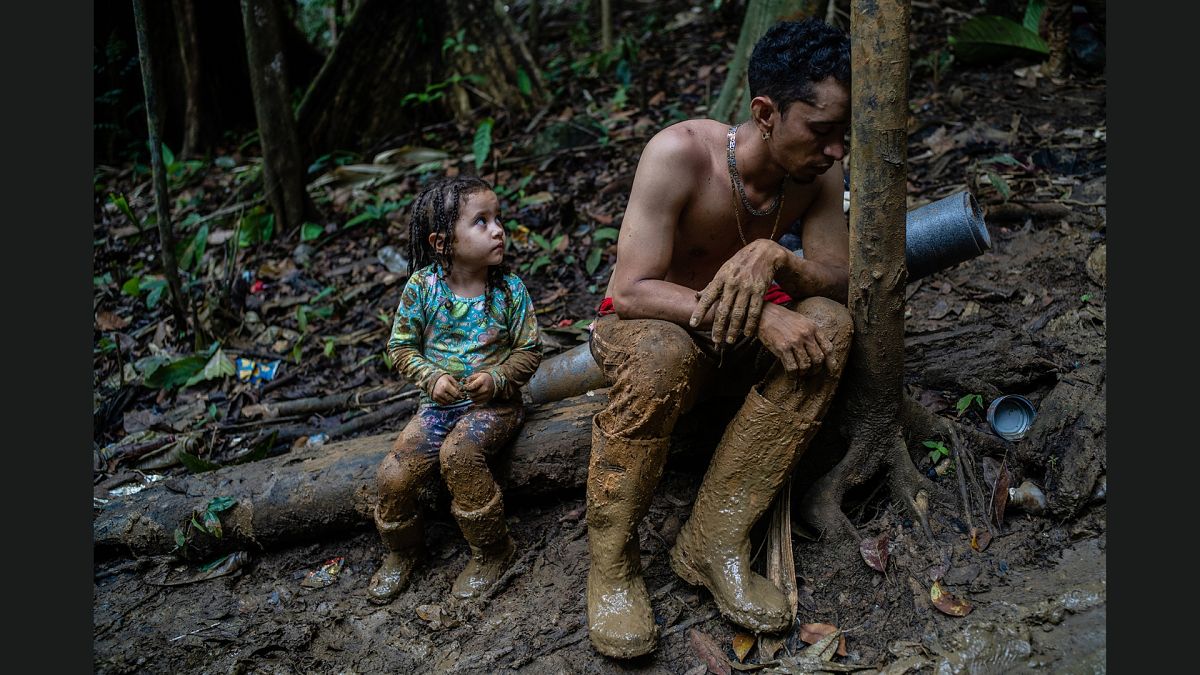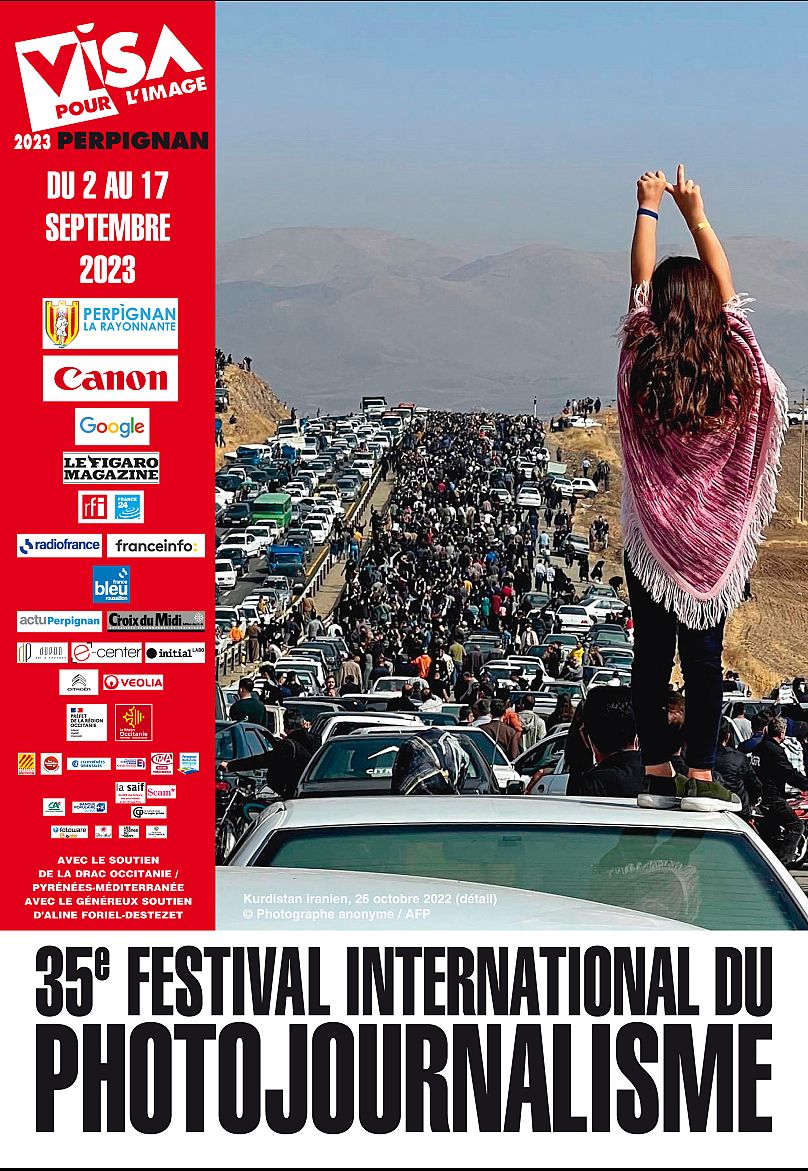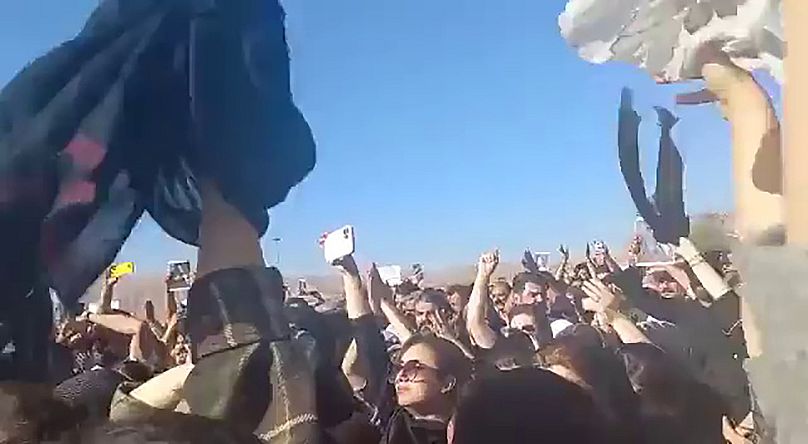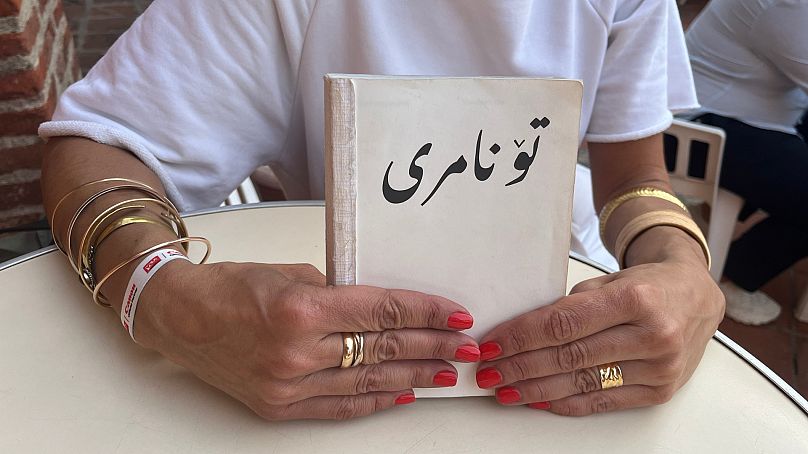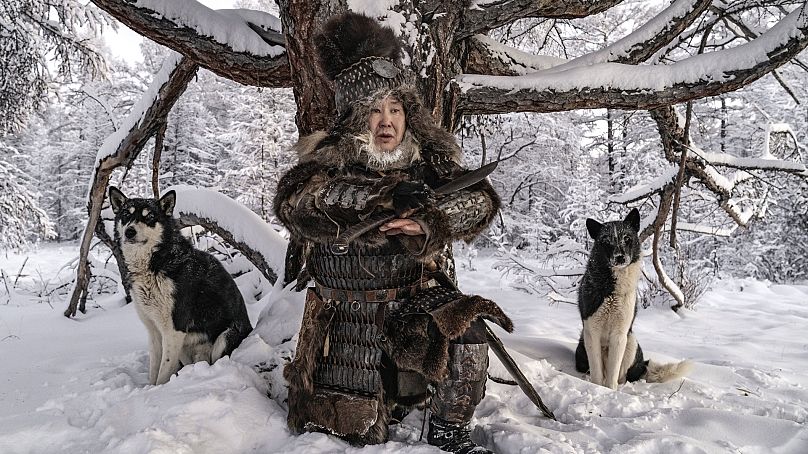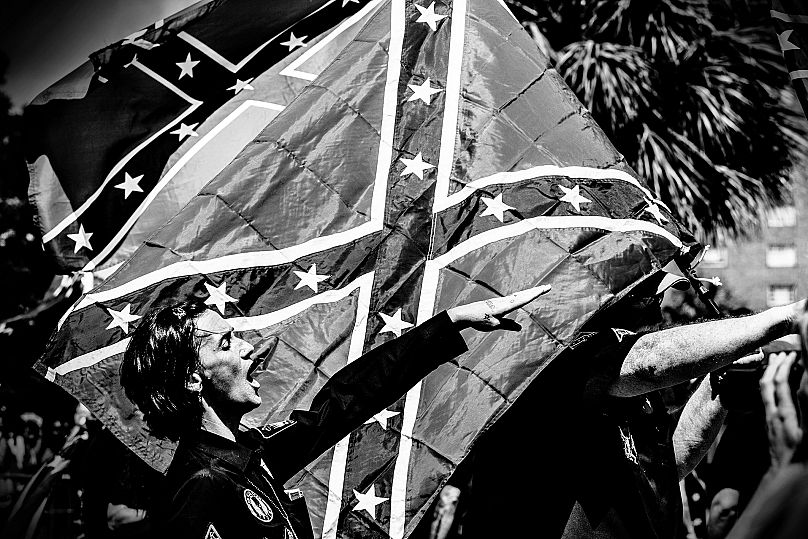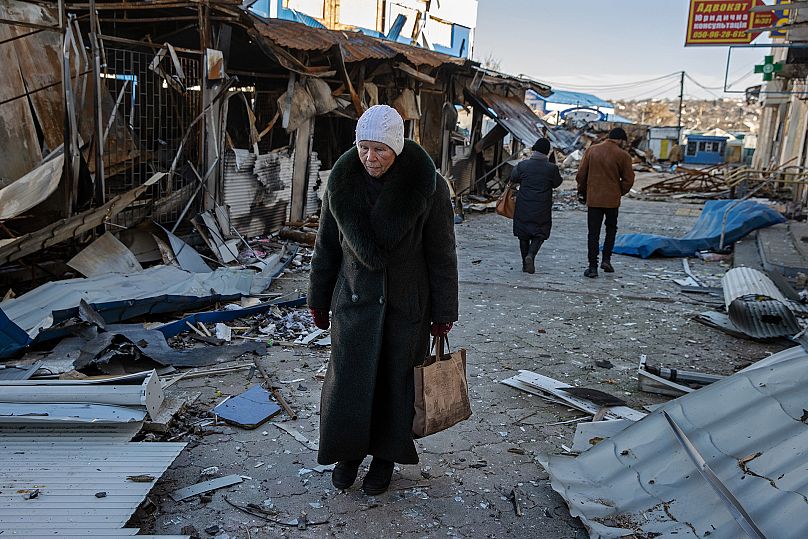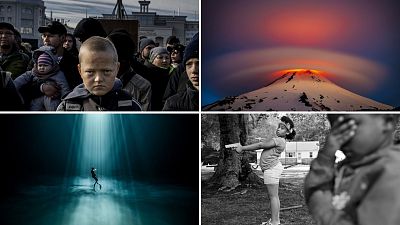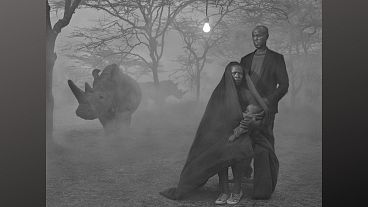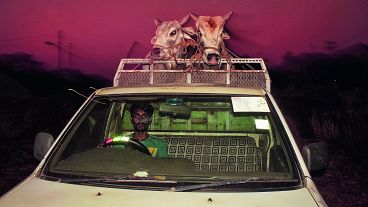The international photojournalism festival is taking place in the southern French city of Perpignan until 17 September, featuring 24 photo exhibitions.
On the official poster for the 35th edition of the international photojournalism festival Visa Pour L’Image is a photo taken by an anonymous photographer.
It shows an Iranian woman standing on top of a car, her long brown hair exposed, holding her hands up in a symbol of victory as thousands of people make their way on foot to the cemetery in Aichi, Iran, where Mahsa Amini is buried.
The photo is representative of the unprecedented public uprising that followed Amini’s death on 16 September 2022 at the hands of Iran’s morality police, and the government crackdown that saw tens of thousands of protesters arrested.
It’s also a symbol of the impossible task of covering the story in images, as foreign reporters were refused visas by Iran’s government and local journalists were arrested and accused of spying.
Though Iran’s crackdown on journalists means there is little official photo documentation of the start of the uprising, the head of Visa Pour L’Image said that was no an excuse not to cover the story at the festival.
“If we had waited for work done by photojournalists, we wouldn’t have had an exhibition on Iran this year,” Jean-François Leroy told Euronews Culture. “So the choice was made for me, because of how important I considered these events and the fact that there was no other way to do it. I don’t know of a single professional photojournalist who was able to cover these events in Iran.”
The resulting exhibition, called “Rebellion in Iran: You Don’t Die,” is a rare sight at the top photojournalism festival in the world – it contains more amateur photographs than professional ones, many of them pixelated screen grabs from shaky cell phone videos shot by local citizens.
One of the videos featured in the exhibition is the viral video of Iranian girls dancing to Selena Gomez' "Calm Down".
Distressing images
One of the rooms is dedicated to a video projection that shows key moments in the uprising captured by Iranians, some of which featured in the French daily newspaper Le Monde’slong-form report this February. Visitors often leave the room with a heavy sigh, the intensity of the raw footage weighing heavily on many of them.
“I couldn’t watch the whole thing,” said Delphine Dumanois, who took the night bus from Germany for the festival. “It was too emotional. But these kinds of images are necessary, they help you wake up from the slumber of your daily life.”
She told Euronews Culture that it was her second time attending the photojournalism festival, which takes place every year in the south-west French city of Perpignan.
Iran: Creative solutions to shrinking press freedoms
The exhibition on Iran was curated by a team of photo editors and journalists at Le Monde as part of its ongoing coverage of the Iranian uprising. It is a testament to the tenacity of the paper’s staff, the relentless resistance of the Iranian people and the deep resolve to tell a story that authorities wanted to bury.
Of the professional photographers who contributed to the exhibition, many chose to remain anonymous for fear they’d be arrested. Some used a pseudonym to protect their identity.
“We left the choice to the photographers,” Le Monde photo editor Marie Sumalla told Euronews Culture. “But the majority of people who sent us the most recent photos, who have been covering the story long-term, asked to use their real names. I think that’s beautiful.”
Sumalla worked closely with Le Monde’s Iran specialist Ghazal Golshini and other Iranian journalists in Europe to verify and select the amateur footage and photos – first for the paper’s regular coverage, and then for the exhibition.
Because of the widespread repression within the country, Sumalla said there was a feeling that these images were slipping away. Some of the photographers who contributed to the exhibition told her they didn’t even keep the original files on their hard drives out of fear of being arrested.
“We were a bit disturbed by the fact that everything we were doing in the end was only temporary,” she said. “What we published on Le Monde’s website will remain, the exhibition will stay up for two weeks, but we wanted to write this moment in ink. Because whether we like it or not, this moment is history, this uprising is unprecedented.”
Their solution was to publish a small paperback photo book, gathering all the different images they had published from the start of the uprising. The title is “You Don’t Die,” inspired by the epithet Amini’s uncle wrote on her tombstone: “Dear Jina (Amini’s Kurdish name), you don’t die. Your name will become a symbol.”
“We wanted a small format that could reach the greatest number of people,” Sumalla said. “Back in the day, before social media, these kinds of small books used to be published, notably in Algeria, to pass along information discreetly from a person to another. The book could fit in your pocket, so messages could be passed along in silence.”
Bringing the world to Perpignan
Silence is one of the most striking aspects of Visa Pour L’Image – there was little conversation as visitors walked the halls of the Couvent Des Minimes, a repurposed 16th century convent that serves as the main exhibition space for the festival.
People come from all over to see the exhibitions – 24 in total this year – that dive deep into some of the most pressing global news stories, from the war in Ukraine and the rise of the far-right in the United States to the erosion of human rights in Afghanistan and the devastating effects of climate change.
“Coming here gives me new insight and perspective on the stories I see in the news,” said Claudia, a 29-year-old journalist who drove in for the festival from Girona, Spain. “It’s a chance to remember things I may have forgotten, and discover new places and cultures I never knew existed.”
“You have to take it in little by little,” said 82-year-old Daniel from Bordeaux. “My takeaway? The world is sad. But it’s important to stay informed on things mainstream media doesn’t often cover.”
Despite amateur photographers featuring prominently in the exhibition on Iran, festival director Leroy insists the work of professional photojournalists is still primordial for communicating what’s really going on in the world.
“Sure, anyone can take photos, but there are still very few photographers out there,” he said. “For me a photojournalist sets off, he knows what he wants to do, he has an idea of the story he wants to tell. Meanwhile, someone with a smartphone might take a photo accidentally or not, but he’s not telling a story. It’s just a series of moments captured on camera.”
Leroy is the founder of Visa Pour L’Image, and has been leading its operations for the past 34 years, maintaining it as one of the premiere photojournalism events of the year.
“Fifteen or 20 years ago a photographer told me, you should be careful, because photographers today, they’re working for World Press Photo and for Perpignan,” he said.
With that influence comes great responsibility. Leroy says he makes a point not to encourage photographers – especially young ones – to take unnecessary risks for shock value.
“When I see all the young journalists who went to Ukraine with no insurance, no backing from a magazine or paper, I think it’s stupid to take that much risk. If you have a good story, you don’t need to take risks.”
Leroy said he received 250 exhibition proposals from Ukraine this year. He refused to look at any of them where the photojournalist was working without insurance.
Leroy admits that photojournalism today is in crisis, with newspapers and magazines producing and paying less, and concerns about the potential impact of artificial intelligence. The latter, however, is a non-issue according to him.
“I’m not worried about this issue of Artificial Intelligence, because – and I can’t say this enough – there are many of us out there who defend the truth represented by photojournalism, and we’re not going to give into AI without a fight.”
